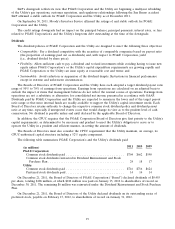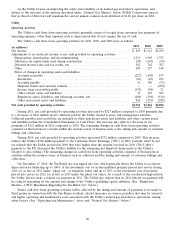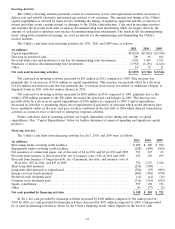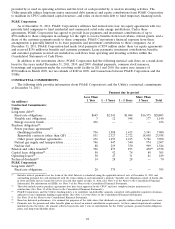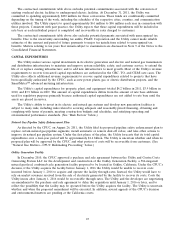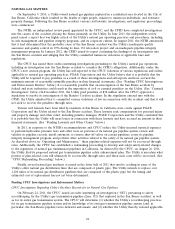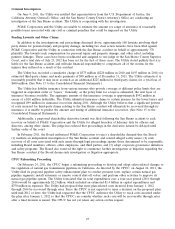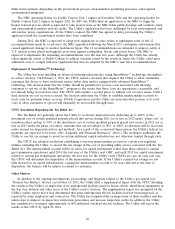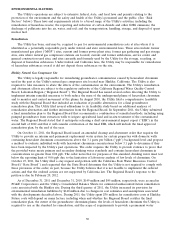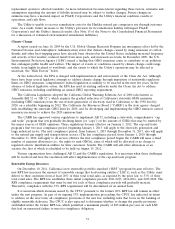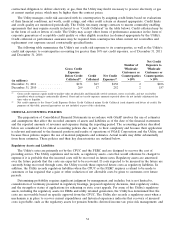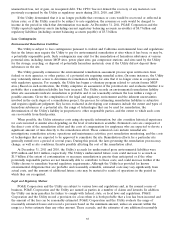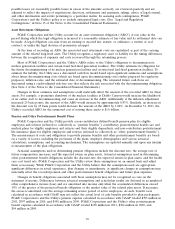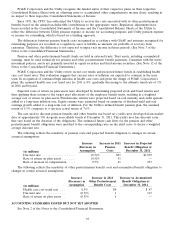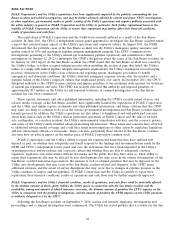PG&E 2011 Annual Report Download - page 33
Download and view the complete annual report
Please find page 33 of the 2011 PG&E annual report below. You can navigate through the pages in the report by either clicking on the pages listed below, or by using the keyword search tool below to find specific information within the annual report.differ from estimates depending on the procurement process, environmental permitting processes, and required
environmental mitigation.
The NRC operating license for Diablo Canyon Unit 1 expires in November 2024 and the operating license for
Diablo Canyon Unit 2 expires in August 2025. In 2009, the Utility filed an application at the NRC to begin the
license renewal process which is expected to take several years as the NRC holds public hearings and conducts safety
and environmental analyses and site audits. The Utility’s application has been challenged by local environmental and
anti-nuclear power organizations. At the Utility’s request, the NRC has agreed to delay processing the Utility’s
application until the seismological studies have been completed.
During 2012, the NRC is expected to adopt new regulations or issue orders to implement some of the 12
recommendations made by a task force the NRC appointed following the March 2011 earthquake and tsunami that
caused significant damage to nuclear facilities in Japan. The 12 recommendations are intended to improve safety at
U.S. nuclear power plants and upgrade protection against earthquakes, floods, and power losses. The NRC is
expected to implement the remaining recommendations over the next five years. Although the Utility has already
taken significant action at Diablo Canyon to address concerns raised by the events in Japan, the Utility could incur
additional costs to comply with new regulations that may be adopted by the NRC’s task force recommendations.
Deployment of SmartMeterTM Technology
The Utility has been installing an advanced metering infrastructure, using SmartMeter technology, throughout
its service territory. On February 1, 2012, the CPUC issued a decision that requires the Utility to allow residential
customers the choice to have traditional meters rather than meters equipped with advanced SmartMeter
technology. The decision finds that the Utility should be permitted to recover costs associated with allowing
customers to opt-out of the SmartMeter program to the extent that those costs are appropriate, reasonable, and
not already being recovered in rates. The CPUC will conduct a second phase to address cost recovery issues. Until a
final decision on cost recovery is issued, the decision authorizes the Utility to establish memorandum accounts to
track costs for potential future recovery. PG&E Corporation and the Utility are uncertain what portion of its total
costs to allow customers to opt-out will ultimately be recoverable through rates.
CPUC Resolution Regarding the Tax Relief Act
The Tax Relief Act generally allows the Utility to accelerate depreciation by deducting up to 100% of the
investment cost of certain qualified property placed into service during 2011 (or as late as 2012 under ‘‘phase out’’ or
transition rules) and up to 50% of the investment cost of certain qualified property placed into service in 2012 (or as
late as 2013 under the phase out rules). Amounts that are not subject to 50% or 100% acceleration will be recovered
under normal tax depreciation lives and methods. As a result of the accelerated depreciation, the Utility’s federal tax
payments are expected to be lower. (See ‘‘Liquidity and Financial Resources’’ above.) The resolution authorizes the
Utility to use the tax savings to invest in certain additional capital infrastructure not otherwise funded through rates.
The CPUC has adopted resolutions establishing a one-way memorandum account for certain rate-regulated
utilities, including the Utility, to record the net change in the cost of providing utility service associated with the Tax
Relief Act. The memorandum account will be in effect for capital investments (other than those related to natural
gas transmission operations) until 2014, the test year of the Utility’s next GRC; and until 2015 for capital investments
related to natural gas transmission operations, the test year for the Utility’s next GT&S rate case. In each rate case,
the CPUC will determine the disposition of the memorandum account. If the Utility’s realized tax savings are not
fully invested in its capital infrastructure, causing the memorandum account to be over-collected at the time of
disposition, the balance will be subject to refund to customers.
Other Matters
In addition to the ongoing investigations, proceedings, and litigation related to the Utility’s gas system (see
‘‘Natural Gas Matters’’ above), on October 14, 2011, the Utility filed a supplemental report with the CPUC detailing
the results of the Utility’s re-inspection of its underground facilities (used to house electric distribution equipment) in
the San Jose division and other areas of the Utility’s service territory. The supplemental report was prompted by the
Utility’s earlier report that it had determined that some underground electric facilities had not been inspected, as
reported by some employees and contractors. The Utility has completed the re-inspections of these facilities and has
taken steps to improve its inspection verification procedures and increase inspection audits. In addition, the Utility
has committed to re-inspect approximately 16,000 additional overhead electric facilities. The Utility will report the
results to the CPUC by April 30, 2012.
29


